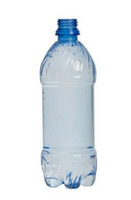








Polyethylene terephthalate (PET), a strong, stiff synthetic fibre and resin, and a member of the polyester family of polymers. PET is spun into fibres for permanent-press fabrics, blow-molded into disposable beverage bottles, and extruded into photographic film and magnetic recording tape.
Wyeth's most famous invention was the plastic soda pop bottle. Wyeth became curious about why plastic was not being used for carbonated beverages, and found out that when plastic was molded into bottles, certain parts of the bottlewere weaker than others and could not withstand the carbonation pressure. Adopting a stretching technique used to strengthen nylon fibers, Wyeth startedexperimenting with cold-stretching plastic molecules. He devised a way to extrude the plastic with crisscrossed flow lines, which reinforced themselves and created a uniformly strong bottle. The plastic he was using, however, was not self-balancing--it kept stretching in one direction until it burst. He switched to polyethylene terephthalate, or PET, which stretched in one place when the limit was reached somewhere else. The result was the first successful plastic soda pop bottle, patented in 1973, and now the industry standard.
PET is produced by the polymerization of ethylene glycol and terephthalic acid. Ethylene glycol is a colourless liquid obtained from ethylene, and terephthalic acid is a crystalline solid obtained from xylene. When heated together under the influence of chemical catalysts, ethylene glycol and terephthalic acid produce PET in the form of a molten, viscous mass that can be spun directly to fibres or solidified for later processing as a plastic. In chemical terms, ethylene glycol is a diol, an alcohol with a molecular structure that contains two hydroxyl (OH) groups, and terephthalic acid is a dicarboxylic aromatic acid, an acid with a molecular structure that contains a large, six-sided carbon (or aromatic) ring and two carboxyl (CO2H) groups. Under the influence of heat and catalysts, the hydroxyl and carboxyl groups react to form ester (CO-O) groups, which serve as the chemical links joining multiple PET units together into long-chain polymers. Water is also produced as a by-product.
PET is made into a high-strength plastic that can be shaped by all the common methods employed with other thermoplastics. Magnetic recording tape and photographic film are produced by extrusion of PET film (often sold under the trademarks Mylar and Melinex). Molten PET can be blow-molded into transparent containers of high strength and rigidity that are also virtually impermeable to gas and liquid. In this form, PET has become widely used in carbonated-beverage bottles and in jars for food processed at low temperatures. The low softening temperature of PET—approximately 70 °C (160 °F) prevents it from being used as a container for hot-filled foods.
PET is the most widely recycled plastic. PET bottles and containers are commonly melted down and spun into fibres for fibrefill or carpets. When collected in a suitably pure state, PET can be recycled into its original uses, and methods have been devised for breaking the polymer down into its chemical precursors for resynthesizing into PET. The recycling code number for PET is #1.